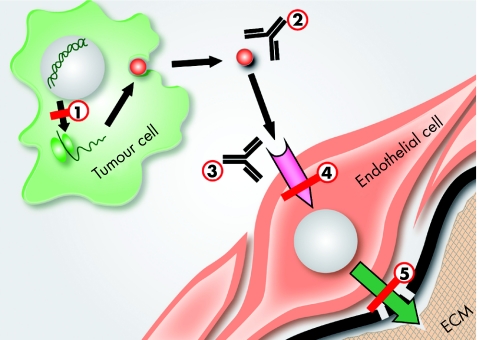Figure 6 Subcellular localisation of antiangiogenic target molecules. The process of tumour associated angiogenesis can potentially be interrupted at various stages in the multistep sequence of tumour associated microvascular angiogenesis. (1) Some tumour cells show enhanced transcription of angiogenic mediators (red dot) (for example, vascular endothelial growth factor (VEGF)). Chemically stabilised phosphorothioate antisense oligonucleotides can be used to interfere with the transcription of angiogenic mediators. (2) Angiogenic mediators can be biologically bound by immunoreactive antibodies (for example, neutralising anti‐VEGF antibodies) or other neutralising peptides (for example, VEGF‐Trap). (3) Similarly, endothelial cell associated receptors specific for the angiogenic mediator (for example, VEGFR2) can be blocked by specifically designed antibodies eliciting competitive binding. (4) Receptor associated angiogenic signalling is often mediated by tyrosine kinases coupled to the angiogenic receptor (for example, VEGFR2 associated tyrosine kinases). Chemical compounds engineered to interfere with the enzymatic activity of these kinases (for example, Vatalanib) can specifically inhibit cytokine mediated endothelial activation. (5) Activated endothelial cells secrete proteases that potently disintegrate the endothelium associated basal lamina (black bold line) and the underlying extracellular matrix (ECM). Chemical compounds designed to block these enzymatic activities (for example, matrix metalloproteinase inhibitors) inhibit this last step in the sequence of tumour associated microvascular angiogenesis.

An official website of the United States government
Here's how you know
Official websites use .gov
A
.gov website belongs to an official
government organization in the United States.
Secure .gov websites use HTTPS
A lock (
) or https:// means you've safely
connected to the .gov website. Share sensitive
information only on official, secure websites.
